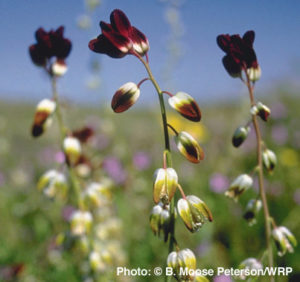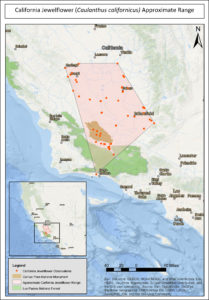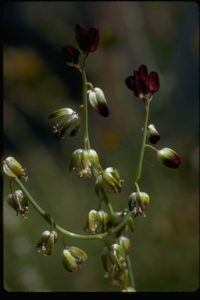Caulanthus californicus
- Endangered – Endangered Species Act (1990)
- Rare Plant Rank 1B.1 – California Native Plant Society
 Description
Description
The California jewelflower is a plant endemic to California that is recognized for its beautiful maroon buds which contrast with the bright white flowers that grow beneath. The plant has hairless, branching stems with tooth-like upper leaves and egg shaped lower ones. The California jewelflower is considered an annual herb as well as a member of the mustard family, or brassicaceae, and normally blooms between mid-March to early May. On July 19, 1990, it was officially listed under the Endangered Species Act as an endangered species.
Habitat
The jewelflower is only found in California and grows in non-native grassland, Upper Sonoran Subshrub Scrub, and Cismontane Juniper Woodland typically at elevations of 200-3,300 feet. They thrive particularly well in sub-alkaline soils. Thick and dense herbaceous cover characterizes most sites where California jewelflower are found, with clovers, red maids, goldfields and annual fescue comprising the vegetation at these locations. On the Carrizo Plain in particular, the jewelflower grows on the burrowing system of giant kangaroo rats, which are another endangered species.
 Distribution
Distribution
The historical range of the California jewelflower, based on specimens collected between 1880 and 1973, was expansive, with the plant growing in the Sierra Nevada foothills, the Carrizo Plain, the Cuyama Valley and the San Joaquin Valley. However, as of 1986, natural occurrences of the jewelflower were extirpated and limited to only three small areas including Santa Barbara Canyon, Carrizo Plain and Kreyhagen Hills. Although the plant has not been found on National Forest lands, occurrences of the jewelflower in the Santa Barbara Canyon are located within 3 miles of Los Padres National Forest. Over these three regions where the California jewelflower is presently located, the total area of occupied habitat is estimated to only be 30 acres, showing its limited range in California. Overall, population trends for the flowering plant are declining as various threats are introduced to the California jewelflower population.
Threats
The main threat that the California jewelflower faces is habitat destruction due to agriculture, urbanization and oilfield activity that demolish the plant and its natural habitat. In Santa Barbara Canyon particularly, these challenges are difficult to control because 90% of the flowers are found on private land, making it nearly impossible to mitigate destruction. Other issues that create issues for the jewelflower include livestock overgrazing, off road vehicle use, competition with other exotic plants, and chemical fertilizers used in the regions where the flowers grow, resulting in a lower overall population.
 Conservation Efforts
Conservation Efforts
Due to the California jewelflower’s population decline, there have been various efforts to conserve the plant. In 1987 biologists undertook extensive surveys of the plants that led to additional monitoring and the discovery of various jewelflower sites that were previously thought to have been eliminated. In 1998, a recovery plan for the California jewelflower was completed. There have also been several experimental introductions of the jewelflower on lands protected by the Los Padres National Forest. Unfortunately, these efforts were unsuccessful as jewelflower populations at these sites eventually declined, but future reintroduction efforts can utilize the experience gained from these early trials to contribute to further conservation efforts.
While the California jewelflower has not been found naturally in the Los Padres National Forest, known occurrences near the national forest boundary have been described by botanists over the years. ForestWatch is working with rare plant experts to survey areas in the Los Padres National Forest where the California jewelflower may be growing based on where it has been observed just outside of the national forest.






